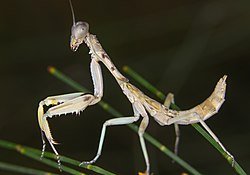| Sphodropoda | |
|---|---|
 | |
| Sphodropoda tristis | |
| Scientific classification | |
| Domain: | Eukaryota |
| Kingdom: | Animalia |
| Phylum: | Arthropoda |
| Class: | Insecta |
| Order: | Mantodea |
| Family: | Mantidae |
| Subfamily: | Mantinae |
| Tribe: | Archimantini |
| Subtribe: | Trachymantina |
| Genus: | Sphodropoda Stal, 1871 |
Sphodropoda is a genus of mantis within the family Mantidae. Members of this genus can be found in Australia. [1] [2]